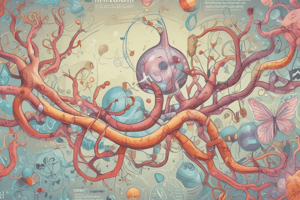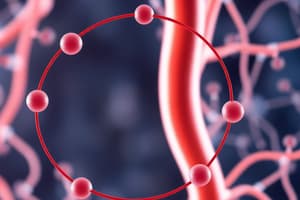Podcast
Questions and Answers
Which compound directly feeds into the TCA cycle after being processed by pyruvate dehydrogenase?
Which compound directly feeds into the TCA cycle after being processed by pyruvate dehydrogenase?
- Oxaloacetate
- Citrate
- Fumarate
- Acetyl-CoA (correct)
What is the primary role of the TCA cycle in cellular metabolism?
What is the primary role of the TCA cycle in cellular metabolism?
- Final oxidative step in the catabolism of carbohydrates, fatty acids, and amino acids (correct)
- Production of glucose
- Direct regeneration of NAD+
- Synthesis of lipids
Who is recognized for linking the sequences of reactions into the TCA cycle and won the Nobel Prize in 1953?
Who is recognized for linking the sequences of reactions into the TCA cycle and won the Nobel Prize in 1953?
- Albert Szent-Györgyi
- Franz Knoop
- Hans Krebs (correct)
- Carl Martius
Which of the following sequences was NOT identified by Szent-Györgyi?
Which of the following sequences was NOT identified by Szent-Györgyi?
Which characteristic relates to the TCA cycle's location within the cell?
Which characteristic relates to the TCA cycle's location within the cell?
Where does the TCA cycle occur within the cell?
Where does the TCA cycle occur within the cell?
Which of the following statements is true regarding the enzymes involved in glycolysis and gluconeogenesis?
Which of the following statements is true regarding the enzymes involved in glycolysis and gluconeogenesis?
Who is the TCA cycle named after?
Who is the TCA cycle named after?
What is the first component of the TCA cycle that is formed?
What is the first component of the TCA cycle that is formed?
Flashcards
TCA Cycle
TCA Cycle
A central metabolic pathway that breaks down fuel molecules, producing energy and intermediates for biosynthesis.
Acetyl-CoA
Acetyl-CoA
The molecule that enters the TCA cycle, derived from the breakdown of glucose.
Krebs Cycle
Krebs Cycle
Another name for the TCA cycle, a fundamental process in energy production.
Mitochondrial Matrix
Mitochondrial Matrix
Signup and view all the flashcards
Citric Acid
Citric Acid
Signup and view all the flashcards
Tricarboxylic Acid Cycle (TCA Cycle)
Tricarboxylic Acid Cycle (TCA Cycle)
Signup and view all the flashcards
Pyruvate dehydrogenase
Pyruvate dehydrogenase
Signup and view all the flashcards
Glycolysis End Product
Glycolysis End Product
Signup and view all the flashcards
Study Notes
The TCA Cycle
- The TCA cycle (also known as the Krebs cycle or Citric Acid cycle) is a central and fundamental metabolic pathway.
- It's a crucial part of cellular respiration, playing a key role in energy production.
- The cycle occurs within the mitochondrial matrix of eukaryotic cells.
Previously... Glycolysis
- Glycolysis is the breakdown of glucose.
- It has a net yield of 2 ATP, 2 NADH, and 2 pyruvate molecules.
- Most glycolysis enzymes are reversible, but three are not.
- Aerobically, pyruvate is converted to Acetyl CoA and enters the TCA cycle.
- Anaerobically, it's fermented to lactate or ethanol to regenerate NAD+.
- Gluconeogenesis uses reversible glycolysis enzymes, but different enzymes are used for irreversible steps.
TCA Cycle - Key Functions
- It's a final common pathway for fuel molecules, entering as Acetyl-CoA.
- It provides energy transfer molecules.
- It produces intermediate molecules for biosynthetic reactions (anabolism).
TCA Cycle - History
- Citrate was first discovered in lemon juice in 1784 and was later found to be widespread.
- In the 1900s, it was demonstrated that minced muscle tissue can catalyze the transfer of hydrogen atoms between some organic acids (succinate, malate, and citrate).
- This process of oxidation was visualized using methylene blue.
- Enzymes involved were termed dehydrogenases.
- In the 1930s, oxygen uptake rate measurements revealed that acids were rapidly oxidized to carbon dioxide.
- Szent-Györgyi connected these observations into a cycle: Succinate → Fumarate → Malate → Oxaloacetate.
- Martius and Knoop discovered another cycle: Citrate → Isocitrate → α-ketoglutarate → Succinate.
- Hans Krebs established the complete TCA cycle, and received the Nobel Prize in Physiology or Medicine 1953
- The cycle is named after Sir Hans Krebs.
- The cycle contains the six-carbon tricarboxylic acid, citric acid (citrate), as the first formed component.
TCA Cycle - Steps (Summary)
- 8 distinct reactions occur.
- Condensation of Acetyl CoA and Oxaloacetate to form Citrate.
- Formation of Isocitrate (via cis-aconitate), moving the OH group.
- Oxidative decarboxylation of Isocitrate to ketoglutarate, releasing CO2.
- Oxidative decarboxylation of ketoglutarate to succinyl-CoA, releasing CO2.
- Conversion of succinyl-CoA to succinate (involves hydrolysis and phosphorylation).
- Oxidation of succinate to fumarate (removing two H+ and forming a double bond).
- Hydration of fumarate to malate.
- Oxidation of malate to oxaloacetate.
TCA Cycle - Regulation
- The cycle's enzymes are regulated by inhibition from high [ATP] and high [product], and stimulation by high [ADP].
- High ATP/ADP ratio leads to phosphorylation, inhibiting PDH.
- Insulin leads to dephosphorylation, stimulating PDH.
- Three key checkpoints exist in the cycle.
- Citrate synthase, Isocitrate dehydrogenase, and α-ketoglutarate dehydrogenase are notable checkpoints.
TCA Cycle - Connection to Glycolysis
- Pyruvate from glycolysis becomes Acetyl CoA in preparation for entering the TCA cycle.
- Pyruvate is converted to Acetyl-CoA, CO2, and NADH (which goes to the electron transport chain).
TCA Cycle - Lipid Metabolism Connection
- Fatty acid degradation through beta-oxidation generates acetyl-CoA, which then enters the TCA cycle.
- Fatty acid biosynthesis is the reverse of this breakdown process.
TCA Cycle - Protein Metabolism Connection
- Proteins are broken down to amino acids, which can undergo transamination and deamination reactions.
- Some amino acid derivatives enter the TCA cycle directly or indirectly, as intermediates.
- Oxaloacetate and α-ketoglutarate are necessary intermediates for amino acid synthesis.
TCA Cycle - Need for Oxygen
- The TCA cycle does not directly use oxygen.
- It generates NADH and FADH2, which then feed into the electron transport chain where oxygen serves as the final electron acceptor.
- NADH and FADH2 are re-oxidized to NAD+ and FAD, respectively, in the electron transport chain.
TCA Cycle - Cofactors
- Cofactors like GTP (or ATP), NADH, and FADH2 are generated during specific steps of the TCA cycle.
- NAD+ and FAD are regenerated by the electron transport chain (which requires oxygen).
- GDP is regenerated to GTP by nucleoside diphosphate kinase.
TCA Cycle- Location in Eukaryotic Cell
- Glycolysis occurs in the cytosol.
- The TCA cycle occurs in the mitochondrial matrix of eukaryotic cells.
- Pyruvate and NADH must cross the mitochondrial membranes (via a shuttle system).
TCA Cycle - ATP Yield
- The maximum ATP yield depends on the shuttle used for transporting electrons across the mitochondrial membrane.
- One molecule of NADH produces 2.5 ATP, and one molecule of FADH2 produces 1.5 ATP.
- The inner mitochondrial membrane is impermeable to NADH which is generated in the cytoplasm.
- Therefore using shuttles to transfer the electrons is essential
Substrate-Level Phosphorylation
- The TCA cycle involves substrate-level phosphorylation, where ATP is generated directly (by direct phosphate transfer from phosphate-rich intermediates)
- if the glycerol-3-phosphate shuttle is utilised, then only 3 ATP are produced (rather than the typical 5)
Summary of the TCA Cycle
- The TCA cycle is a part of cellular respiration that connects with carbohydrate metabolism, and lipid and amino acid metabolisms to generate high energy electron carrier molecules.
- It's regulated by product inhibition and ATP levels.
- Anaplerotic reactions replenish the intermediates of the cycle that are used for biosynthesis.
- The cycle plays an important role in energy generation, enabling complex anabolic reactions.
Other Notes
- Specific values for energy released (in terms of ATP) should be reviewed depending on what exact shuttle is being used.
- Multiple diagrams in the pages cover various aspects of the TCA cycle for different perspectives.
Studying That Suits You
Use AI to generate personalized quizzes and flashcards to suit your learning preferences.




